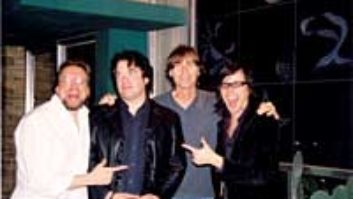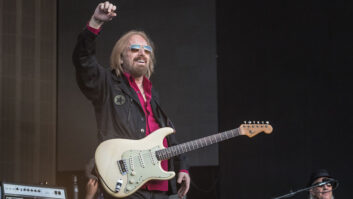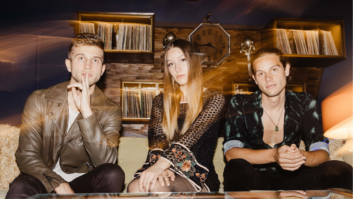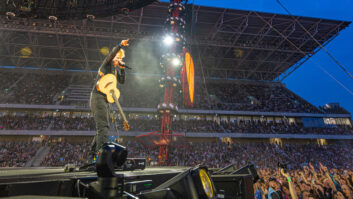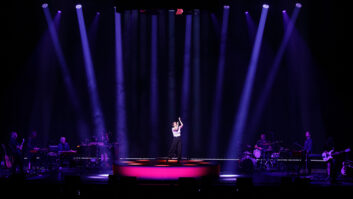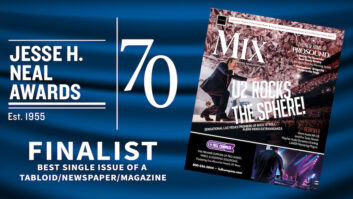People unfamiliar with the Christian music industry are often surprised to discover not only its diversity, but just how big it is. Christian music sales in the past three years, according to the RIAA, have constituted almost six percent of the industry total, outselling jazz and classical combined.
This is a world that Nashville-based engineer/producer Tom Laune knows well. Some 15 years ago, after honing his recording skills with rock and alt-rock bands, Laune was searching for a career direction in harmony with his values. The contemporary Christian market proved a fit, and it wasn’t long after that he became one of the busiest engineers in the genre. Now, with a number of best-selling albums under his belt for such artists as Amy Grant, Chris Rice, Nichole Nordeman, Rich Mullins and Michael W. Smith, along with a Dove Award and a Grammy™ nomination, he’s been able to create his dream home studio.
Known as a technology maven, Laune is an avid gear collector with a serious penchant for customized systems. When I hooked up with him by phone one afternoon for a chat, his enthusiasm for new and innovative equipment was contagious; obviously, this is a guy who loves both his work and the tools he uses to do it.
You don’t sound like you’re from the South.
I grew up in Nebraska, where I played electric bass in bands all through high school. I also took it upon myself to try to record one of them — hilarious. It was, “We don’t sound anything like my favorite Tom Petty records! What’s the problem?” That’s when I decided to go to college and get a degree in recording engineering. Back in 1983, Memphis State University had a really nice studio they’d just opened.
I knew early on that I wanted to be on the technical side. But in high school, I had the rather false notion that being an engineer wouldn’t be as competitive as being a musician. I thought it would be easier and more stable. Of course, the truth is, being a recording engineer is just as competitive as anything else in the music industry.
What happened after school?
After two years at Memphis State, I was accepted for an internship at Ardent [Studios in Memphis]. That turned into a job as the “night guy,” answering phones and cleaning up. After I graduated, I was hired on as a staff engineer. That’s where I learned my chops working with amazing artists from R.E.M. and the Fabulous Thunderbirds to The Radiators and Keith Richards — all incredible rock albums. I was on-staff for six years, and I got some really good breaks. Someone like [R.E.M. producer] Scott Litt would bring in his own engineer and I would second, but for the indie bands, I’d get to first engineer.
Why did you move to Nashville?
Out of total necessity. I got involved in the contemporary Christian music industry with my good friend and spiritual mentor, Pat Scholes. We found an artist — Steve Wiggins — who I produced and shopped, and we got him a record deal. He was just a guy who sent me a tape, but he went on to front the band Big Tent Revival and had several Number One songs.
You were specifically looking for Christian artists?
Yes. When I was 23, I became a Christian and I wanted to get into the genre. I was really excited to do that kind of music because of its positive message. I thought I could take my experience and produce a really good Christian record.
Anyway, it worked. I got Steve Wiggins a deal with Sparrow Records, one of the largest Christian labels. And that got me inroads with the person who was the head of A&R back then, Peter York. Peter is now the president of Sparrow/EMI. I credit him with being the guy who opened doors for me to get involved in the Christian music industry. He hooked me up with [producer] Brown Bannister, and the next thing I knew, I was slammed busy. For a while, I got producers to come to Memphis and work at Ardent. But pretty soon, they wanted me in Nashville. I love Nashville, but it was hard to leave Memphis and the people I knew there.
You are known for staying in the forefront of technology.
When Pro Tools was really beginning to be a viable option, I was co-producing a record with Phil Keaggy for Word Records. I decided that if I bought a system, we wouldn’t have to rent a studio. That’s what I did, and I was hooked. I got Michael Cronin, an amazing studio builder, to build my studio in our walk-out basement. I knew we’d be there a long time and that I’d be bringing a lot of high-profile clients, so I had him do it right. It’s a great, isolated, acoustically treated facility, but it’s in my house where I can just walk downstairs to go to work.
Your setup is a hybrid?
The sound that I enjoy is a combination of lots of analog signal processing with Pro Tools. I record to Pro Tools, but because I like the depth and imaging you get from an analog mixer, I use an external mix bus. I do all my automation inside of Pro Tools, so I have the advantage of Pro Tools recallability, but I take individual channels out of it and use an analog mix bus.
So you need a lot of D-to-A converters.
I generally use 48 D/A converters for the mix, with an extra eight I/O for the analog equipment I use as inserts. I have four Digidesign 192s, which I think sound great. Three of them have 16 D/As each; the fourth one I use for eight analog I/O and eight digital I/O.
Can you describe your custom-built console?
I wanted to create a mixer that had 64 inputs with the ability to run the mix through five different-sounding mix buses. The idea was to pull up your mix and decide — based on the song — what flavor of console you would like to mix through. The hardest part about building this one-of-a-kind mixer was finding all of the original parts. Some are from a vintage API, some from a Neve 8068, some were Daniel N. Flickinger parts. I also had Cameron Labs create a unique tube mix bus, which sounds amazing! For the absolute SSL-type, colorless, ultraclean mix bus, we included one based on Jensen 990 operational amplifiers and discrete electronics.
You also have a new API mixer.
I’m a fan of the newer API sound, and I use their modular mixer as another color to choose from. I have six of the 8200 8-channel line mixers. They have level, pan, sends, mute and solo. I also have the 7800 master control module, which they all plug into. The 7800 gives me all of the stereo bus controls, with inserts for a compressor or mastering EQ.
I also had something very cool made. With this system, there are no faders, only knobs. If you want to do an analog fade, you literally have to do it with a big knob, which doesn’t work for me. API had the insight to put external fader inputs onto the back of the 7800. There are two ¼-inch TRS jacks that allow you to plug in an external master fader. But API doesn’t sell an external master fader and neither does anybody else. So I had one made, which took a couple of months, but was worth it.
The API modules and the 192s are in my machine room. In my control room, I have the master fader. If I’m mixing to my ½-inch analog machine, I can go right out of the 7800 and into that. If I’m mixing to my Alesis MasterLink, I use a Crane Song HEDD [Harmonically Enhanced Digital Device] 192 converter. It sounds awesome, and what makes it really special is something that Dave Hill, the designer, just added on the newer model: It has a great tape saturation feature that allows you to simulate what it sounds like when tape overloads.
What’s really magic about all of this is that I can get the sound of mixing through a console, but I still have the total recall of Pro Tools. To give you an idea, I’ve been mixing a live record for the last week. Yesterday, everybody signed off on the mixes. Last night, I recalled and printed 13 mixes from 10 p.m. to 2 a.m. I don’t think I could have done that any other way than with my current setup.
You use a lot of analog processing. How does that fit into your recalls?
Since I have so much analog gear, I can leave the individual units set. I have a rack of eight channels of API 550B EQ, which I use for premastering. If I want a different EQ setting on a different song, I can just switch to another pair of modules. If I need to change something on them, they’re easy to recall because they’re all detented. I try to buy as little analog outboard gear as possible that isn’t detented.
What’s your setup for recording?
Ardent Studios had one of the first Mitsubishi 32-track digital recorders, so, starting out, I had to learn how to make things sound great before they hit the recording media. I never got accustomed to having tape help me get the sound I wanted. For me, digital was always the means of capture; it’s about getting the sound right on the front end.
To do that, I use a wide array of gear. I use API and Neve mic pre’s and EQ. I’m also into a company called Thermionic Culture, which I discovered when I was working in London a few years ago. I’ve got their Culture Vulture, which is a really awesome-sounding rackmount tube distortion box. I’ve used it on vocals to give them a nasty grunge sound for rock mixes and on drum overheads to push the drums forward in the mix.
I also have four channels of Aurora Audio GTQ2s, which are 2-channel, Class-A, mic pre/3-band EQs with transformer I/O. They sound similar to a Neve 1073 mic pre/EQ and are built by former Neve engineer Geoff Tanner. They have limited EQ, but they’re very musical. I love them on toms and guitars. I also love the Alan Smart compressor for that wonderful SSL quad bus compressor sound.
In the music you work on, vocals and lyrics are key. What equipment do you use to record them?
Definitely my first choice for a mic pre is a custom-made tube pre by Fred Cameron, which, when I’m cutting vocals, adds a really nice texture. It’s huge and open-sounding. It also has limited EQ, but just enough to make a vocal sparkle.
What about that first thing in the chain: the mic?
Lately, I’ve been loving the Korby convertible mic. It has the ability to switch between four different capsules. My favorites are the 251 and the U67.
Do you use a lot of older mics?
Not necessarily. I’m a really big fan of B&K. I’ve got a pair of 4011s, their cardioid mic, which has a nice 20dB pad. You can do great stuff with that on acoustic guitars and drum overheads. They’re probably one of the most clear and open-sounding mics made. I’m also a big fan of Royer, who I had custom-tune my ribbon for a hotter output.
After they did that, I sent my Royers, which are very low impedance, to Fred Cameron, who matched the impedance of the microphones to his mic pre. Now I have a condenser ribbon switch on my mic pre that gives me 10 to 12 dB more gain when I switch to the matched impedance position.
Obviously, you’re a guy who really needs his own studio customized to your own particular taste.
I love being able to work in my own environment with no one coming in and messing things up.
Do you leave a drum kit always set up?
Actually, I never leave a drum kit set up. I start fresh every time. With drums, it just varies too much depending on the project. Somebody might want a vintage kit; another person might want it really ambient. The next person will want it completely dead and dry. I like to start from scratch. That’s how I was brought up at Ardent.
I pretty much do that with everything. Instead of leaving things up, I strike and start over, because you can definitely get in ruts. That’s part of why I’m also such a big proponent of checking out and cycling new gear. I always want to know what’s new out there. I have to admit, I hang out a lot on Gearsluts.com.
Just by nature, I enjoy trying new things. Lately, I’m really into mixing for picture; I’ve been doing a lot of live DVD concerts in surround. I find it a lot of fun, for example, that when there’s a close-up of a certain instrument, you need to make it pop sonically. And once you get the surround bug, it is real hard to go back.
What’s your surround setup?
Surround is part of the reason I’ve got eight channels of the API 550B detented 4-band parametric EQ. I use that for premastering to get the overall balance and add a little analog warmth. I do use the internal mix bus in Pro Tools for doing surround. But when you’re able to spread out sounds over six or more channels instead of two, it really sounds great. I also have an Edit Pack by Digidesign. It’s two channels of motorized joystick surround panners, which work amazingly well. It’s like grabbing a motorized fader — it connects up right to ProControl. Check it out on my Website, www.tomlaune.com.
What about speakers?
I’ve tried just about everything, but I’ve been into [Yamaha] NS-10s since the early ’80s and I still use them. For a long time, I used Dynaudio M2s, but they were too big for this control room. Now I have a pair of Dynaudio BM15As. I still do 99 percent of everything, including surround mixing, on five NS-10s with a Bag End Infrasub. As a matter of fact, I’ve got another surround setup upstairs in my living room with five NS-10s.
I just think NS-10s rock, but they need two things: supplementary subwoofers to complement the low end and you have to kill them with power. I’ve got Hafler P3000 amplifiers in mono on every NS-10. I’m giving each one a 400-watt monoblock power amp. When I run them full-on, they sound absolutely amazing.
I have three 18-inch Bag End subwoofers in this studio: the ELF system. I use it to extend the low frequencies of the NS-10s, and then I have a totally separate Bag End 18, the Infrasub, with a built-in 400-watt amp that I use as my LFE channel for mixing in 5.1. I like to keep the frequency extension speakers and my LFE speaker totally separate. That way, I really know what I’m doing. With the turn of a knob, I can listen to the NS-10s either flat or with the low frequencies extended down to below 20 Hz.
So you have all of these different listening environments.
I’d never be able to rig all this stuff if it wasn’t my own room! A client can hear the NS-10s flat with no subwoofer if they want, and then I have the ELF system set up so, just where the NS-10s roll off, they supplement. It’s a very seamless transition. And I have the Dynaudio BM15As, which I run completely flat without any LFE for a totally different viewpoint.
I also have another room in my studio set up for 5.1 with the Alesis ProActive 5.1 monitoring environment with built-in Dolby and DTS decoder. It’s wild: The power amps for the subwoofer and the five satellite speakers are built into the subwoofer. It’s awesome for referencing outside my control room, and it’s something you can buy off the shelf for about $400! It’s one of the few things that interfaces well with game audio, and it’s also a great secondary reference system. I have it so that I can burn reference surround discs and listen in that environment for a totally different perspective.
In my control room, I’ve got a Pioneer Elite universal player, which plays all formats: DVD-A, SACD and CD. In the other room, I have Pioneer’s new, inexpensive universal player that sells for less than $200. It works great and sounds great. I also have Playstation 2 that I listen to, set up in surround, going into the Alesis. It’s optical right out of Playstation into the Dolby decoder.
I get the impression that you’re pretty excited about the future!
Absolutely. The record business is changing every day, and I’m always trying to stay as far ahead of the curve as possible. It’s easier for me because I’m not a huge corporation: I can react quickly to new trends and technology. Squeezing every drop of energy and emotion from the music I work on is what really gets me excited. Getting to play with new gear is just a bonus!
Maureen Droney is Mix‘s L.A. editor.
Selected Discography
M: Mixer; P: Producer; E: Engineer Audio Adrenaline:Lift 5.1 DVD (M, 2002)
Rich Mullins:Songs (E/M, 1993), A Liturgy, A Legacy & A Ragamuffin Band (E/M, 1993)
Nichole Nordeman:Woven and Spun (M, 2002)
Passion Worship Band:Passions: Hymns Ancient and Modern (E, 2004), Sacred Revolutions (E, 2003), Our Love Is Loud (P/M/E, 2002)
Chris Rice:Smell the Color 9 (M, 2000)
Michael W. Smith:Worship box set (P/E/M, 2004), Second Decade 1993-2003 (P, 2003), Worship (P/E/M, 2001)
Bruce Springsteen: “Gypsy Woman” (M, 1994)
Watermark:All Things New (P/E/M, 2000)
